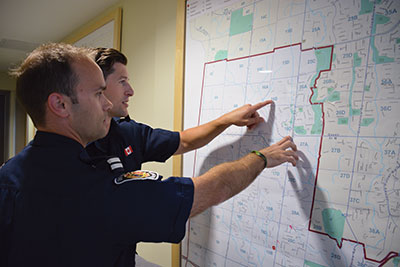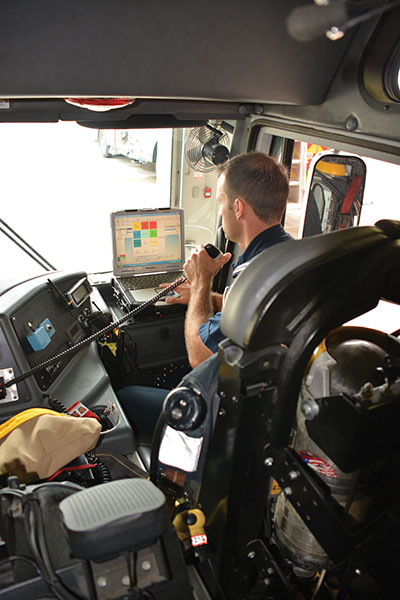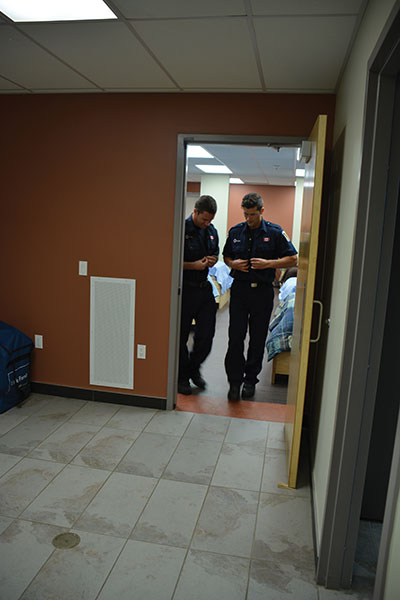
Features
Hot topics
Response
Editor’s pick 2014: Crunching numbers
A review of response-time data in Brampton, Ont., shows that little things – the location of the printer and maps, the distance to the truck bay from firefighters’ living quarters, and whether crews start moving before hearing the entire page – can save valuable time and push departments closer to the NFPA response-time standard.
August 26, 2014
By Bill Boyes
A review of response-time data in Brampton, Ont., shows that little things – the location of the printer and maps, the distance to the truck bay from firefighters’ living quarters, and whether crews start moving before hearing the entire page – can save valuable time and push departments closer to the NFPA response-time standard.
 |
|
| A study by Brampton Fire and Emergency Services in Ontario shows that small changes – the location of the printer and maps, the distance to the truck bay from firefighters’ living quarters, and whether crews start moving before hearing the entire page – can save valuable time and push departments closer to the NFPA response-time standard. Photos by Laura King
|
Bigger changes, such as a high-tech fire station alerting system, can make a significant impact on response times, but they also cost money.
Understanding how response-time data is collected and analyzed is important in order for departments to make sure conclusions drawn from the information are accurate.
Departments that want to try to reduce response times to meet NFPA 1710 can learn from Brampton’s experience.
* * *
All organizations, including the fire service, must assess organizational capabilities to ensure all relevant legislation is adhered to and industry-best practices are followed.
While fire departments are complex organizations, their data management and evaluation processes are typically less than optimal.
Intuitively, a decrease in response times will improve life safety and property protection by optimizing emergency-response performance. Knowledge of all response time components, from the placement of the 911 call to the arrival on scene, is critical to ensure effective and cost-efficient improvements are made, while maximizing public safety and avoiding unnecessary spending.
The fire service best practice for response times is outlined in 1710; 80 seconds to the 90th percentile is the de facto benchmark, but it is not mandatory. It is unclear how many, if any, North American departments meet that benchmark.
Acknowledging the importance of turnout time, in early 2013, Brampton Fire and Emergency Services (BFES) in Ontario convened a working group of labour and management representatives to study turnout times and work toward achieving the NFPA standard.
Essentially, the study found that technology has a significant impact on operations and changing simple things – moving trucks around in the bay, better lighting, putting the printer closer to the maps – can make a significant difference to turnout times.
BFES comprises 468 personnel in a community of 600,000 residents. Brampton is Canada’s ninth largest city and the fastest-growing municipality in Canada. The city is served by 13 fire stations that respond to 18,000 emergencies each year.
BFES conducted a comprehensive review of its turnout times from 2011 to 2013. A thorough investigation into response times of other departments across the province was not conducted due to the challenges of fire-service data comparison. While the Brampton study was taking place, the Ontario Association of Fire Chiefs’ response-time committee developed an accepted timeline to be used in Ontario (mirroring NFPA 1710) to ensure all departments use the same language and definitions when conducting response-time analyses.
In 2010, an audit of Atlanta Fire Rescue found turnout times for both EMS and fire incidents are about three times longer than the NFPA standard. In 2010, Atlanta had a turnout time of 187 seconds to the 90th percentile. Interestingly, and based on past practice, the City of Atlanta published median statistics as opposed to percentile-based statistics, which hid the magnitude of the problem.
This highlights the critical importance of understanding the difference between basic statistical terms such as median, mean and percentile. The mean is the average, the median is the 50th percentile, and NFPA 1710 requires the 90th percentile. Fire departments must ensure they measure and report their data clearly and align their data with the applicable industry statutes or standards.
In a 2010 study, researchers from Worcester Polytechnic Institute analyzed simulated and actual turnout times from a wide range of departments. More than 400 North American departments were contacted to participate; however, just 14 of the 59 respondents met the criteria to participate in the study. Many departments lacked complete or accurate data, which eliminated them from participating.
In the end, the study questioned the validity of the NFPA 1710 turnout-time standard, saying it “may be unrealistically short in today’s fire-service environment and may encourage unsafe practices in an effort to meet unrealistic alarm handling and turnout objectives.”
* * *
Brampton conducted a detailed analysis of response data using an internal data analytics program. It was quickly discovered there were substantial problems with the data-collection procedures and resulting statistics; these systems failed to capture accurate turnout times.
 |
|
| In Brampton, the back-end delay was determined to be five seconds. Brampton activated the mobile data units (MDUs) – the computers in the trucks similar to those in police cars – to allow the captain to press the F1 button to stop turnout time.
|
Basically, the program was not using the correct computer-aided dispatch (CAD) time stamps when calculating turnout time. Months later, an interim solution was developed with help from the communications division and corporate IT staff. Surprisingly, the use of the correct data did not result in any significant improvements. The analytics program allowed turnout time to be explored at the overall, shift, station and apparatus levels. The turnout times ranged from 143 seconds in 2011 to 141 seconds in 2012 to 131 seconds in 2013.
Quickly, it became evident that there were two major contributing factors to these inflated times: the front-end transmission delay and the back-end transmission delay.
NFPA 1710 defines turnout time as “the time interval that begins when the emergency response facilities and emergency response units notification process begins by either an audible alarm or visual annunciation or both and ends at the beginning point of travel time.”
In Brampton, turnout time commences when the dispatcher chooses the tactical radio channel. Although turnout time has commenced, firefighters in the station have not been notified by the audible alarm. There is a transmission delay because the dispatcher has to select the required apparatus and begin the dispatch sequence. The delay is typically longer in departments that use manual station-alerting systems. Further analysis revealed the front-end transmission delay to be 25 seconds, on average.
Therefore, it becomes crucial to understand how your department’s dispatch and data collection processes align with the NFPA definition so that you can correctly ascertain the source of the time delays. Are the delays operational or technologically based?
In Brampton, to overcome the front-end transmission delay, a new station-alerting system is scheduled to be installed later this year. This system will include a countdown clock, automated in-station lighting and improved acoustics through ramped tones and text-to-speech dispatch. The countdown clock provides real-time feedback on turnout-time performance and is a visual cue for firefighters to assess their turnout response procedures. Although the new system is a significant capital investment shared by the three fire departments in Peel Region, the potential time reductions that will be realized justify the expense.
Compounding the front-end delay is a similar issue that exists when the captain radios “on the way” to the timestamp that occurs on the computer when the dispatcher selects the appropriate vehicle and inputs the apparatus as en route.
Within this back-end delay are two components: first, the time it takes to say P204, on the way, 123 Smith St., house fire, all belted; and secondly, the time required for the dispatcher to manually enter the apparatus as en route.
In Brampton, we determined the back-end delay to be five seconds. To overcome this delay, we have activated the mobile data units (MDUs) – the computers in the trucks similar to those in police cars – to allow the captain to press the F1 button to stop turnout time. The verbal “on the way” announcement is still used to inform other apparatuses on the call for operational purposes; this allows all trucks to simultaneously respond without having to wait to get on the radio because of traffic. Hence, turnout time is no longer affected by radio traffic or any human inputting factors.
Coupled with the 25-second front-end transmission delay, a value of 30 seconds was determined for the overall transmission delay. The graph above provides a comparative analysis of Brampton turnout times (minus the transmission delay) to the NFPA 1710 benchmarks. The data clearly shows a substantial reduction in the gap between NFPA and Brampton turnout times if the delay is removed.
The operational issues encountered varied in terms of the impact on turnout time, but the time constraints of NFPA 1710 necessitate an analysis of all possible contributing factors.
In Brampton, the length of the dispatch announcement is 25 seconds. Turnout time is severely impacted if crews listen to the full announcement before moving toward the trucks. If crews at two-truck halls listen to the dispatch announcement to decipher which apparatus is required, their turnout time increases. Firefighters must move to the apparatus at the first sound of the alert sequence. All information provided in the announcement is available on the MDU, which eliminates the need for firefighters to listen to the full announcement before heading to the trucks.
Fire-station design is another variable to be considered when assessing turnout time. Each fire station has unique challenges and travel components that need to be addressed to determine the time it takes personnel to reach the trucks; for example, the time required to get from the living quarters or the dormitory to the apparatuses.
Printers must be situated to minimize travel distance when preparing to respond to a call. In one Brampton station, moving the printer would decrease the travel distance by 26 feet, saving 5.1 seconds on each response.
Furthermore, it was determined that some trucks were not in the most effective positions within the stations. Moving trucks to the bays closest to the living-quarters entrance would save four seconds per response.
 |
|
The study found that the maps in the stations are difficult to read; differentiating a street from a map area boundary, or locating the actual street, was problematic. Station map boards were not properly lit at night or situated in the best locations. The incident printouts are ineffective and contribute to delays in turnout time as they are not incident specific and contain a lot of unnecessary information that clutters the page. Pinpointing the address on the map portion of the printout would be a significant improvement. We also found that the cross streets provided are not necessarily major intersections. Altering the maps to include only major intersections nearest the incident enables the driver to get the apparatus going in the right direction and the captain can hone in on the exact location while en route using the MDU.
Given the occupational health and safety concerns of promoting quicker turnout times at the expense of safety, it is important to understand how department polices, SOGs and legislation impact turnout time. Donning PPE and seatbelts takes time. All Brampton personnel were advised throughout this study (and moving forward) that striving to meet the 80-second goal does not mean any policies or legislation could be disregarded. Donning PPE prior to putting on a seatbelt is mandatory before the truck leaves the station.
Brampton uses MDUs in all front-line apparatuses. This study alerted us to the fact that MDU training for firefighters was lacking and needed to be addressed. Sufficient education and training was not provided on rollout of the MDU and resulted in limited usage of this valuable tool. It was determined that increased use of the MDU would be a key step toward the 80-second goal. To facilitate the widespread adoption of the MDU, a trial was conducted to determine how a change in turnout procedure would affect overall turnout times. The results were positive, despite initial hesitation by firefighters to change their past practices and rely on a technological tool. As of July, mandatory roads and maps training is required each month, and a new turnout procedure has been implemented. The new procedure – detailed below – is very simple: essentially, on hearing the alert tones, all personnel move immediately – they do not listen to full dispatch announcement.
■ Driver
- Obtains the map from printer.
- a) Correct map = go to the truck; confirm captain has MDU ready, work with captain to reach incident.
b) No map = go to map board, confirm route with captain, proceed to incident (contingency plan in case of printer malfunction) - Turn on truck and don seatbelt.
■ Captain
- Moves directly to truck on hearing alarm.
- Dons PPE, seatbelt and ensures all personnel are belted.
- Ensures MDU received call.
- Pulls up map on MDU.
- Radios – “P204 on the way.”
- Go to red pin on the MDU map.
■ Firefighters
- Proceed straight to truck.
- Don PPE.
- Don seatbelts.
- Close bay door (if necessary).
Brampton has experienced sizable growth over the past two decades, increasing the number of fire personnel and stations and impacting turnout time. An unfamiliar incident location requires the driver to spend time studying maps to determine a route. This negatively impacts turnout time, especially if the captain assists the driver at the map board, as he/she will be the last person to board the apparatus. This issue is compounded when acting captains are assigned to different stations and are unfamiliar with the response area.
Improvements to turnout times could be made if driver specialists were created. In addition to the turnout-time improvements, specialized drivers could help with apparatus-inventory controls, greater awareness of defective and missing equipment, greater familiarity with truck equipment and locations, safer responses, increased familiarity with pre-plans, greater entry control and accountability competency, and more expertise as pump operators.
One final operational finding involved the need for continuous performance measurement. It was recommended that a reporting protocol be developed within CAD for captains to detail abnormally high turnout times. The threshold value will be determined on implementation of the new fire station alerting system, but turnout-time specific issues can be addressed regularly.
Finally, it is imperative that all personnel are advised of their performance to understand how they are doing. In Brampton, this will be accomplished through the use of monthly reports detailing turnout-time statistics, starting later this year.
There are some general lessons that can be taken from Brampton’s experience. Fire departments must ask themselves a few important questions related to data:
- Do you fully understand the available data?
- Have you anticipated the data you may need and how you will collect it?
- Where does the data come from?
- Is it easily accessible?
- Who are the gatekeepers of the data?
- Although you may believe you have the necessary data, can you get it in a timely manner?
- Is the data valid and reliable?
- How is the data collected?
- What are the underlying assumptions and/or limitations of the data?
For Brampton Fire and Emergency Services, this project has resulted in significant changes that are impacting the entire department. By understanding the data available and placing an increased emphasis on the importance of valid and reliable data, our department is adjusting to realities of the new public sector that demands accountability and efficiency. Moreover, it aligns with the department’s mission statement: to protect our community with trained professionals through active partnerships, providing the highest quality preventative, educational and emergency services.
 |
|
| In Brampton, the length of the dispatch announcement is 25 seconds. Turnout time is impacted if crews listen to the full announcement before moving toward the trucks.
|
The purchase and implementation of an automated fire station alerting (FSA) system is a substantial capital investment that will positively impact Brampton’s turnout times and our overall customer service.
Leveraging our current technological capabilities (MDU’s), coupled with a new turnout procedure and the appropriate training to support this initiative, will improve our current level of service.
Brampton’s turnout times in 2014 have been steadily decreasing and should continue to decrease with the new turnout procedure and MDU protocols that began in June. Moreover, the transmission delay will be removed in late 2014 with the new FSA, which should significantly reduce overall turnout times. Brampton anticipates reaching the NFPA standard in the near future and ensuring all past and future recommendations aid in reaching this highly sought-after goal.
The NFPA standard of 80 seconds to the 90th percentile requires a long-term commitment using incremental rather than revolutionary change and continuous assessment to ensure department practices are conducive to achieving the 80-second goal.
Capt. William Boyes of Brampton Fire & Emergency Services is a PhD candidate in human resources management at York University, which supplements his Master’s degree in public policy and administration and Bachelor’s degree in public management from the University of Guelph. Boyes was recently accepted into the USFA executive fire officer program in Emmitsburg, Md. Contact him at william.boyes@brampton.ca
Print this page